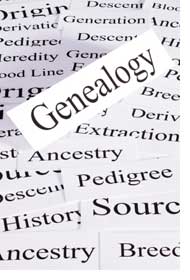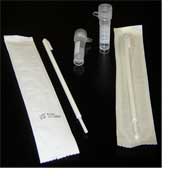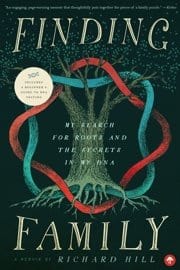
NOTE: Richard Hill founded the DNA Testing Adviser website and managed it until August 2021. The details of his personal search for birth parents are both fascinating and educational. He shared his story over four separate pages and, with permission, his first-person words have been preserved here.
The next breakthrough in the search for my birth father came from genealogy DNA testing. This page will explain how I discovered that new science and how I applied it to my adoption search. I believe my experience and insights can help other adoptees do the same thing.
Born and adopted in 1946, I didn’t get involved in finding birth parents until 1981. I soon identified my birth mother, who had died in 1947. But it was 1990 before I could meet the man she named as my birth father. Then parental DNA testing proved he could not be my father.
DNA and Genealogy
In 2006 my wife and I were out with a group of friends. One of them mentioned that he was using genealogy DNA testing to trace his family tree. He was using an online service called Family Tree DNA. When I got home, I checked out their web site to learn more about genealogy DNA testing.
The Y-DNA Test
The test my friend used was a Y-DNA test, which checks certain markers on a male’s Y chromosome. These markers pass on, more or less unchanged, from father to son, generation after generation. And in Western Civilizations, surnames pass on the same way.
The actual values of those DNA markers were not important for my purpose. I wanted to discover the surnames of people who matched me. Barring any name changes in our genetic lines, my best matches should have the same last name as my unknown birth father.
Genealogy DNA Testing

I received the DNA testing kit with a DNA swab to collect cells inside my cheeks. I returned my samples with the signed Release Form.
[Signing the release form is critical to learning about your matches.]
The test was easy and painless.
Which Test to Buy?
I didn’t know if genealogy DNA testing would work, So I purchased the lowest price Y-DNA test, which only checks 12 markers. After the analysis, I immediately matched over 40 people already in their database. Notices of additional matches keep coming in as more people are tested. I currently have over one hundred matches at the 12-marker level.
The 12-marker matches proved to be worthless for adoption search, because everyone had different surnames. So I upgraded to 37 markers and waited for more results. Since they already had my DNA on file, I did not have to submit another sample.
One Perfect Match
I had one perfect match on the first 25 markers. This man only did a 25-marker test, so I could not know then how we compared on the next 12 markers. According to Family Tree DNA’s Time Predictor, he and I had an 85% chance of a common ancestor within 8 generations.
[When doing genealogy DNA testing, the 37-marker test is the new minimum. They also offer 111 markers, which offers more precision should you see too many close matches at 37 markers.]
Checking the Match
I used the email address of the person I matched to contact him. Since my mother had lived in the Detroit area, I asked if any of his family had lived in Michigan during the 1940’s. He lives in Florida and did not know of any family connection to Michigan.
Our solid DNA match was still a strong indication that my unknown biological father should have this man’s surname. The common ancestor could have been farther back in time than he knew. And a separate branch of his family tree could have extended into Michigan.
Narrowing My Search
I reviewed my old search notes to see if anyone around my birth mother had this surname. One person suddenly jumped out at me. The owner of the bar where my mother worked on weekends had the same surname as my DNA match in Florida.
This was my Eureka moment!
I felt in my gut that this man was my father. But what had happened to him after that? Was he still alive?
Finding My Family
My notes described the bar owner as a married man in his 30’s. The fact that he was married could explain why my birth mother falsely named another (unmarried) man as my father.
Since more than 60 years had passed, I realized that he was unlikely to be alive. Once again I would be too late to meet my biological parent. But I wanted to learn more about him and find any half-siblings.
After a couple months of diligent research, I finally tracked down a niece of this man and explained my story. She welcomed me warmly and I quickly learned a lot about him and other members of this large family.
Three More Hurdles to Overcome
My search was not finished. In my mind I still had to overcome three hurdles to prove my biological roots:
1. I still didn’t know how this family in Michigan connected to my DNA match in Florida.
2. Genealogy DNA testing–at least the Y-DNA test–can only indicate the broad surname tree. It cannot place me in any particular branch or confirm a close relationship to an individual person.
3. The bar owner had four brothers, all of whom were in the Detroit area at the time my birth mother got pregnant. Since she worked at their brother’s bar, any of them could have met her. I had no evidence of that. But I could not rule them out.
Conventional Genealogy Hits a Brick Wall
The first hurdle got me interested in conventional genealogy. My probable birth father’s family had been in Texas since 1859. Some came to Michigan in the 1940’s. I was able to trace the family’s migration backward through the southern states to Franklin County, North Carolina in the late 1700’s.
My Florida match also traces his family back to Franklin County, North Carolina in the same time period. We’re certain these ancestors were relatives. But the common ancestor was probably from King and Queen County, Virginia.
The Union Army burned that county’s courthouse in 1864, destroying all official records of births, deaths, and marriages. Confirming our exact connection may be impossible. And this northerner now understands the phrase “Damn Yankees.”
Additional Matches Confirm the Family
Family Tree DNA sponsors hundreds of DNA surname projects. I joined the one for my probable surname. Since then, additional men with the same surname did genealogy DNA testing and matched my Y-DNA. One of them had the genealogical data to connect us.
My great-great grandfather born in Franklin County, North Carolina and his g-g-g-great grandfather were brothers. Their father was our common ancestor. Counting up and down our family trees, we are separated by a total of 10 generations.
One More DNA Test Needed.
I had learned all I could from genealogy DNA testing. I knew I had the right family. But I still had five possible fathers, all deceased. More DNA testing was needed…so I tried the only option available at the time: a DNA Sibling Test.
Read the Entire Story in My Book

I have written a book that tells my whole story with all the details and all the highs and lows. In it, I describe in detail every DNA test that I took to finally learn the truth about my biological roots.
Whether you are trying to find birth parents or just craving a darn good read, this is a book you will likely devour in one sitting…and wholeheartedly recommend to others.
Finding Family: My Search for Roots and the Secrets in My DNA
